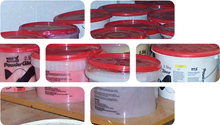
Paint Miscellaneous 20 01 28
Paints that are not hazardous arise in a wide range of types, colours and containers depending on their intended use. Non hazardous paints include water-based paint, non-halogenated paint and epoxy/polyester powder paint. They may be of varying age, quality and condition depending on where and how they have been stored and if the container has been compromised. Beware of paints in containers where the lid is poorly fitting to avoid spillage. This DRIDS Excludes Hazardous Paints which include PVC paint, lead paint, some non-halogenated and epoxy/polyester powder paints, oil-based paints, solvent-based paints and halogenated paints - see separate DRIDS.
Usage & Probable Locations
Paint is used as a coating to protect, colour and enhance products, walls, ceilings, fixtures and fittings. Paint is packaged in containers that are made from metal or plastic in a wide range of styles, sizes and volumes. They are commonly marked with the supplier's name, brand and colour. Paints in containers are commonly found in cupboards, store rooms, maintenance depots and basements. Hazardous paints may also display the Control of Substances Hazardous to Health (COSHH) international symbol - refer to Further Reading
Personal Protective Equipment
PPE requirements indicated are for guidance purposes only. DRIDS has identified the PPE that is mandatory on all demolition projects and ones that may be required subject to site specific Risk Assessment & Method Statement (RAMS). Hover over the icon to determine the types of PPE required for the removal of this material.
Removal, Segregation & Storage
Paints destined for reuse should be segregated and stored carefully and safely to ensure their integrity and good condition. They should be stacked on pallets or in a separate container to prevent damage or spills. Preferably they should be stored inside a building or under cover before removal from site. Non hazardous paints are banned from landfill. Any hazardous paints should be stored separately and treated appropriately - refer to Hazardous Paint DRIDS.
Fixtures, Fittings & Connections
Health & Safety
Subject to task-specific Risk Assessment & Method Statement (RAMS). Wear gloves and face mask when handling paints in containers to prevent irritation, cuts and abrasion. Use eye protection when using hand tools. Wash hands before eating or drinking. Be alert to hazardous paints and their correct symbols in order to recognise and treat them accordingly. Be aware of dermatitis and use correct personal protection and treatment if exposed.










